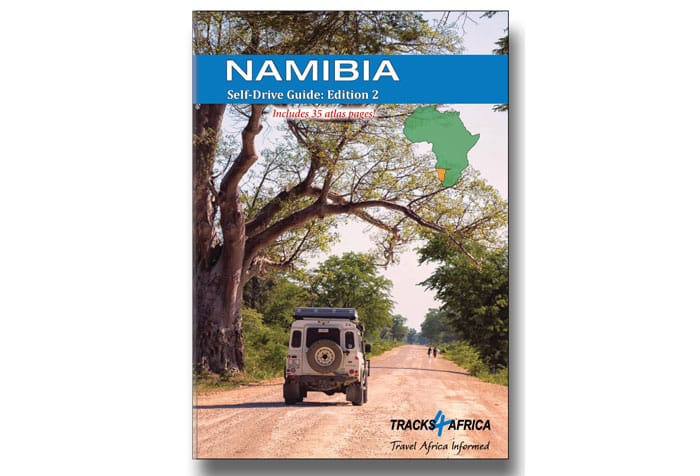Planning a road trip to Namibia? Need a blueprint for your travels? Get the guide written for overlanders, by overlanders. By Romi Boom
Based on the experiences of a community of road trippers, the Namibia Self-Drive Guide by Tracks4Africa tells you exactly what to expect and how to plan. This book is indispensable for first-timers who are intimidated by the sheer size of the country and its plethora of attractions. It also has amazing tips even for old hands – those travellers who return year after year because they simply cannot get enough of Namibia. Having travelled extensively throughout this fascinating self-drive destination, I keenly plunged into the colourful pages that evoke memories of vast open spaces, harsh desert conditions and watery wonderlands. Namibia has it all.
Buy online: Namibia Self-Drive Guide: Edition 2 for R600
I turned straight away to the section “Suggested Routes”. If you’re planning a grand tour to Namibia (17 days, or combined with Botswana, 21 days), look no further than these two detailed itineraries. Both are designed as circular routes, starting and ending in Windhoek, but you can also navigate it from your nearest border post. Optional detours are discussed and handy information given about the duration of such tour extensions.
Also read: What you need to get through the border
Tips that will make your life easier
What sets this book apart from other guides, is that all the homework has been done by travellers who have driven the roads themselves. This means you can benefit from exact information not only about distance, but also about time required to complete each leg of the trip. Tips are legion, from where to stop for famous apple strudel pie (Helmeringhausen) to where and when you’d be better off in self-catering digs than your tent (Swakopmund in winter).
Much of Namibia is remote and the roads rugged, so what to do when the going gets tough? The book tells you when to try an alternative GPS routing and where to ask lodge staff about road conditions and water levels. Campers are advised about luxury campsites instead of run-down pitches. Straight from the inside track, it advises you where to buy wood and where to fill up your tank. It even tells you whether you should have a long-range tank or whether jerrycans will do the trick.
Also read: Not-to-be-missed activities in Namibia
How to navigate check points
Border posts and veterinary gates can be daunting, unless you’re well prepared and abide by the rules. Only two Namibian border posts are open 24 hours, all the others keep idiosyncratic hours, so best to check before you’re stuck. In an attempt to control foot-and-mouth disease, the movement of raw meat (even vacuum packed or deep frozen) and animal products is prohibited, but only when you’re travelling from north to south and from east to west, not the other way around. A detailed map indicates the vet fences with red lines, as well as the checkpoints. At control points, don’t be surprised if you have to exit your vehicle and walk on a mat with disinfecting solution. Since extra shoes will also have to be disinfected, the experts suggest you keep them all in a box, so that the solution does not rub off on your gear.
Also read: Veterinary fences in Namibia and Botswana
The nitty-gritty on planning
Aside from the practical information about the nitty-gritty of travelling in Namibia, the book offers a wealth of sensible suggestions. Not sure what to pack? As a devotee of the minimalist approach, this had me chuckling: “Only take the things you absolutely need. And understand the difference between ‘need’, ‘want’ and ‘might come in handy’.”
Instead of compiling your own camping packing list through trial and error (my own personal lodestar has been tweaked over many years), T4A makes it easy by listing the must-haves for shelter and preparing your food, as well as the technical hardware to include. Top tip: “Don’t take anything you’ve never used before. And make sure you know how to use everything you take.”
New to this second edition are 35 atlas pages at a scale of 1:1000000, in other words, 1 cm on the map equals 10km on the ground. As on the T4A paper maps, top tourist attractions are given, as well as driving conditions. The atlas maps are up-to-date and show essential facilities, camping, lodging and protected areas. This is useful for planning purposes as well as when you’re actually travelling.
The book’s A4 size is bigger than most guides, and while it will not fit into the glove compartment, it should travel comfortably under or behind your seat. The large format allows you to scribble in the margins, moreover it makes for a very visual publication with eye-catching colour photographs throughout. The exquisite landscapes will make you yearn to go see for yourself and the fun travel shots will inspire your own compositions. Wherever you decide to go, your Namibian destinations will be enhanced by detailed descriptions of the different regions. Start dreaming and planning!
- Buy the second edition Namibia Self-Drive Guide Book
- Buy the second edition Botswana Self-Drive Guide Book
- R200 off when you buy both new Namibia and Botswana Self-Drive Guide Books together



“”Tips are legion, from where to stop for famous apple strudel pie (Helmeringhausen) to where and when you’d be better off in self-catering digs than your tent (Swakopmund in winter).””..must be a typo…not Helmeringhausen but Solitaire…
And yes I have the first one that came out and now also the new one. Well done again! Wonderful wealth of knowledge. A pity it did not stay in the A5 size but I understand why you had to change to A4. One book a traveller must have!